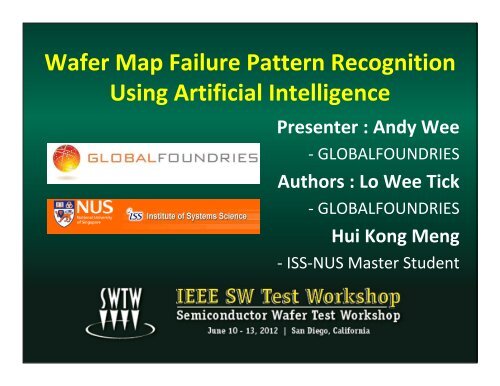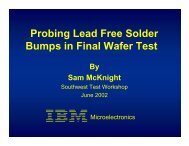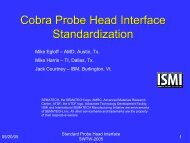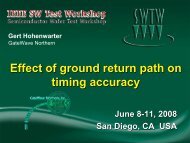Wafer Map Failure Pattern Recognition Using Artificial Intelligence
Wafer Map Failure Pattern Recognition Using Artificial Intelligence
Wafer Map Failure Pattern Recognition Using Artificial Intelligence
You also want an ePaper? Increase the reach of your titles
YUMPU automatically turns print PDFs into web optimized ePapers that Google loves.
<strong>Wafer</strong> <strong>Map</strong> <strong>Failure</strong> <strong>Pattern</strong> <strong>Recognition</strong><br />
<strong>Using</strong> <strong>Artificial</strong> <strong>Intelligence</strong><br />
Presenter : Andy Wee<br />
‐ GLOBALFOUNDRIES<br />
Authors : Lo Wee Tick<br />
‐ GLOBALFOUNDRIES<br />
Hui Kong Meng<br />
‐ ISS‐NUS Master Student
Background<br />
• Probing methodology getting more complex with :<br />
– Increased parallelism<br />
– Optimized probing path to reduce step indexing time<br />
• Adds challenges to wafer disposition :<br />
– Unnecessary retesting of wafers<br />
• Leading to loss of test capacity<br />
• Hardware pre‐mature end‐of‐life (EOL)<br />
• Added cost to overall test operation<br />
– <strong>Failure</strong> to recover overkill dies<br />
• Revenue leak due to throwing away potential good dies<br />
–Highly dependent on past experiences<br />
•Lost domain knowledge<br />
•Time consuming<br />
2
Background<br />
• Disposition challenges<br />
Single Site<br />
‐ Possible<br />
probing issues<br />
Single Site<br />
‐ Possible<br />
wafer issues<br />
Multi‐Site<br />
‐ Could be<br />
wafer issues<br />
Multi‐Site<br />
‐ Could be<br />
probing issues<br />
3
Background<br />
• What are we trying to solve?<br />
– <strong>Recognition</strong> / Decision problem!!<br />
Hunting<br />
Season!!!<br />
DUCK<br />
or<br />
BUNNY???<br />
4
Objectives<br />
• Create a tool to help recognize wafer failure<br />
pattern using AI (<strong>Artificial</strong> <strong>Intelligence</strong>) to help :<br />
–<strong>Wafer</strong> test disposition decision<br />
– Reduce wafer test results review time<br />
–Retain knowledge gained<br />
–Create a more systematic way for wafer disposition<br />
process<br />
5
Typical Outsourced Disposition Flow<br />
Test House<br />
First Pass Test<br />
Completed<br />
Decisions!<br />
Decisions<br />
Decisions<br />
Customer<br />
Lot<br />
Disposition<br />
Retest<br />
selected dies<br />
Retest<br />
needed?<br />
Customer<br />
Disposition<br />
Move to next<br />
process<br />
Retest<br />
needed?<br />
6
Approach<br />
• Extract useable parameters from available test data to<br />
compute statistical information.<br />
• Create database for data insertion<br />
• Select suitable AI methodology for model learning e.g.<br />
NN (Neural‐Network) supervised learning, to identify<br />
recoverable failures detect various pattern failure<br />
scenarios.<br />
• Develop novel algorithms to detect various pattern<br />
failure scenarios.<br />
• Develop a rule‐based algorithm on logical assessment<br />
of information.<br />
7
Development overview<br />
Stage 1 Stage 2 Stage 3 Stage 4 Stage 5<br />
Test data<br />
cleansing<br />
and parsing<br />
Test data<br />
insertion<br />
into<br />
database<br />
Generate<br />
lot & wafer<br />
level<br />
summary<br />
statistics<br />
and wafer<br />
maps<br />
Apply KE<br />
algorithm<br />
and<br />
establish<br />
findings<br />
Generate<br />
report and<br />
recommend<br />
actions<br />
Synthetic Task<br />
Analytic Task<br />
Design<br />
Modeling<br />
Prediction<br />
Monitoring<br />
Planning<br />
Diagnosis<br />
Assignment<br />
Scheduling<br />
Classification<br />
Assessment<br />
8
Phase 1 : Data preparation (1)<br />
• Understanding the data<br />
– Decision to use STDF (Standard Test Data Format) that is<br />
readily available in all major ATEs<br />
–Decode the STDF binary format to sieve out required data<br />
• Cleansing the data for database insertion<br />
– Filter out flawed data e.g. missing information, misplaced<br />
fields etc.<br />
• Mining the data<br />
– Identify critical parameters and compute statistical data as<br />
input nodes<br />
– Select training data sets based on the disposition scenarios<br />
– Select test data sets for verification<br />
9
Phase 1 : Data preparation (2)<br />
• Some example of useful data<br />
–To detect system failure, trouble spots pattern<br />
Input Detection Verification Output<br />
1. X‐Y coordinates<br />
2. Soft Bins<br />
Soft Bins<br />
1. Start with each<br />
failure die as seed.<br />
2. Cluster failing dies to<br />
determine if there is<br />
grouping beyond set<br />
a threshold.<br />
–To detect “Known Recoverable Bins”<br />
1. Repeated signature<br />
in some wafers,<br />
adjacent wafers.<br />
2. Independent of<br />
tester or H/W used,<br />
cluster will still fail.<br />
Cluster failure True<br />
/ False?<br />
Quadrant location?<br />
Input Detection Verification Output<br />
Recoverable list of soft<br />
bins<br />
Recovery history on<br />
different wafers, first<br />
probe, online reprobe<br />
etc.<br />
Probability of<br />
subjecting to retest<br />
10
Phase 1 : Data preparation (3)<br />
• Some example of useful data<br />
–To detect Parametric signature<br />
Input Detection Verification Output<br />
1. X‐Y coordinates<br />
2. Bin failure<br />
3. Failing parametric<br />
value<br />
<strong>Map</strong> failing<br />
parametric value to<br />
population (?)<br />
Test values recorded<br />
near limits?<br />
Probability of<br />
recovery after<br />
retest.<br />
11
Phase 2 : System selection<br />
• Modular system upon which new KE (Knowledge<br />
Engineering) techniques can be added.<br />
• Self‐learning system upon which new models can be<br />
added.<br />
• Configurable with different rules for different devices,<br />
different knowledge.<br />
• Configurable thresholds to detect various failure<br />
patterns.<br />
• Web‐based reports, easier access.<br />
• Database approach for scalable repository.<br />
12
Phase 3 : System structure (1)<br />
• Overview –Data Processing<br />
Test<br />
Definition<br />
Parametric<br />
Test<br />
S/B to H/B<br />
mapping<br />
Bias<br />
Conditions<br />
Bin Limit<br />
Test<br />
Program<br />
Prober<br />
Step Seq.<br />
TEST<br />
STDF STDF STDF<br />
Data Cleansing<br />
Report<br />
Generation<br />
Data<br />
Processing<br />
Enterprise<br />
Database<br />
Report Generation<br />
Analysis<br />
Device<br />
Yield<br />
H/W Trend<br />
H/B<br />
wafermap<br />
S/B<br />
wafermap<br />
Bin<br />
Summary<br />
Parametric<br />
Analysis<br />
Loadboard<br />
Probecard<br />
Parametric<br />
Test Summary<br />
Retest Pickup<br />
Analysis<br />
<strong>Wafer</strong><br />
Region<br />
Analysis<br />
Retest<br />
Pickup<br />
Analysis<br />
13
Phase 3 : System structure (2)<br />
• Overview – Modules<br />
STDF STDF STDF<br />
Pending<br />
Archive<br />
Asynchronous<br />
background<br />
tasks<br />
Messaging<br />
trigger<br />
Computation<br />
Compute<br />
statistics<br />
Process Error Insertion<br />
Compute<br />
KE Algo<br />
Submit<br />
Request<br />
YES<br />
Formatter<br />
Enterprise<br />
Database<br />
Generate<br />
reports<br />
User notification<br />
once data available<br />
and processed<br />
NO<br />
Data<br />
available<br />
?<br />
Client or Web‐based UI<br />
14
Phase 3 : System structure (3)<br />
• Overview – Hybrid <strong>Intelligence</strong> System<br />
INPUT<br />
Stack <strong>Map</strong>s<br />
Parametric Data<br />
Fail Bin Data<br />
Lot Statistical Data<br />
<strong>Wafer</strong> Statistical Data<br />
BP*<br />
J48<br />
SVM*<br />
Electrical Analysis<br />
Ensemble<br />
Hybrid NN Component<br />
<strong>Wafer</strong> <strong>Pattern</strong> <strong>Recognition</strong><br />
(customized search algo)<br />
Predict<br />
probability<br />
of recovery<br />
<strong>Pattern</strong><br />
• Line<br />
•Segment<br />
• Arc<br />
Rule<br />
Based<br />
Engine<br />
R<br />
E<br />
C<br />
O<br />
M<br />
M<br />
E<br />
N<br />
D<br />
A<br />
T<br />
I<br />
O<br />
N<br />
Note:<br />
BP - Backward Propagation<br />
SVM – Support Vector Machine<br />
15
Phase 3 : System structure (4)<br />
• Overview –AI System Modelling and Ensemble<br />
Input Type<br />
dxy*<br />
Bearing<br />
Testval1*<br />
Testval2*<br />
Testval3*<br />
Testval4*<br />
Testval5*<br />
Count<br />
Segment<br />
Stack*<br />
Neural Network<br />
Multi‐layer<br />
Feed Forward<br />
Back Propagation<br />
(NN‐MLFF‐BP)<br />
Decision Tree ‐ J48<br />
Support Vector<br />
Machine<br />
Ensemble<br />
OUTPUT<br />
*Note:<br />
dxy – Euclidean distance<br />
Testval – Top parametric fail values<br />
Segment – Neighboring failures<br />
Stack – Stack map data<br />
16
Phase 3 : System structure (5)<br />
• AI Modeling and Ensemble –How it integrate<br />
Ensemble System<br />
BP_Output<br />
G_bp<br />
J48_Output<br />
G_J48<br />
OUTPUT<br />
SVM_Output<br />
G_SVM<br />
f(t)<br />
Trained Values<br />
G_bp = 75/(75+84+81) = 0.3125<br />
BP J48 SVM<br />
G_c45 = 84/(75+84+81) = 0.35<br />
75.00% 84.00% 81.00%<br />
G_svm = 81/(75+84+81) = 0.3375<br />
x = Bp_output * G_bp + J48_output * G_j48 + SVM_output * G_svm<br />
f(t) x >= 0.6666,<br />
0 otherwise<br />
17
Phase 3 : System structure (6)<br />
• Details of the AI model employed<br />
NN-MLFF-BP<br />
J48 Decision Tree<br />
SVM<br />
18
Phase 3 : System structure (7)<br />
• Domain Knowledge<br />
<strong>Wafer</strong>/Lot low<br />
yield<br />
<strong>Wafer</strong> fabrication<br />
Bump defects<br />
<strong>Wafer</strong> probing<br />
Mask<br />
defects<br />
Process<br />
defects<br />
Systematic<br />
pattern<br />
failure<br />
Random<br />
pattern<br />
failure<br />
Test setup<br />
Systematic<br />
pattern<br />
failure<br />
Random<br />
pattern<br />
failure<br />
Probe card<br />
Prober<br />
Wrong<br />
test<br />
program<br />
Localized<br />
spot<br />
Edge rim<br />
failures<br />
Low<br />
performance<br />
site<br />
Site to site<br />
Planarity<br />
H/W issue<br />
PE cards<br />
Interface<br />
Connection<br />
19
Phase 3 : System structure (8)<br />
• Rule‐based Engine Logic (translated Domain Knowledge)<br />
Yield Yield NN <strong>Pattern</strong> Message<br />
Ave,<br />
1st<br />
Pass<br />
Ave, Auto<br />
Recovery<br />
1st<br />
Pass<br />
Yield<br />
Auto<br />
Reprobe<br />
Recovery<br />
Ave. Auto<br />
Reprobe<br />
Recovery<br />
Recovery<br />
Predict<br />
Count<br />
NN Predict<br />
Yield<br />
Uncertainty<br />
Line<br />
Count<br />
Arc<br />
Count<br />
Segment<br />
Count<br />
H L L FP:L, AR:L<br />
M L FP:M,AR:L<br />
L M FP:L,AR:M<br />
M M FP:M,AR:M<br />
L H FP:L,AR:H<br />
M H FP:M,AR:H<br />
H<br />
H<br />
M<br />
L<br />
NN:H,UC:M,<br />
RT:F<br />
NN:H,UC:L,<br />
RT:F<br />
>0 Line<br />
>0 ARC<br />
>0 Segment<br />
20
Phase 4 : <strong>Pattern</strong> <strong>Recognition</strong><br />
• Arc Detection<br />
Methodology (1)<br />
Definition + Training<br />
Filter results<br />
+<br />
Identification<br />
21
Phase 4 : <strong>Pattern</strong> <strong>Recognition</strong><br />
• Line Detection<br />
Methodology (2)<br />
Definition + Training<br />
Filter results<br />
+<br />
Identification<br />
22
Phase 4 : <strong>Pattern</strong> <strong>Recognition</strong><br />
• Segment Detection<br />
Methodology (3)<br />
Definition + Training<br />
Filter results<br />
+<br />
Identification<br />
23
Phase 5 : Testing and Results (1)<br />
• Results from AI Model (Training Sets)<br />
Items NN-MLFF-BP J48 SVM<br />
Total Instances 38,122 38,122 38,122<br />
Correctly Classified Instances 27,391 (71.8509 %) 30,932 (81.1395 %) 29,907 (78.4508 %)<br />
Incorrectly Classified Instances 10,731 (28.1491 %) 7,190 (18.8605 %) 8,215 (21.5492 %)<br />
Kappa statistic 0.4008 0.6032 0.539<br />
Mean absolute error 0.3494 0.2584 0.2155<br />
Root mean squared error 0.423 0.373 0.4642<br />
Relative absolute error 72.6676 % 53.7533 % 44.8202 %<br />
Root relative squared error 86.2723 % 76.0688 % 94.6788 %<br />
Coverage of cases (0.95 level) 99.6695 % 98.0562 % 78.4508 %<br />
Mean rel. region size (0.95 level) 94.233 % 83.5646 % 50 %<br />
24
Phase 5 : Testing and Results (2)<br />
• Results from AI Model (Test Sets)<br />
Items NN-MLFF-BP J48 SVM<br />
Total Instances 3997 3997 3997<br />
Correctly Classified Instances 69.85245% 69.9775% 71.6537%<br />
Incorrectly Classified Instances 30.1476% 30.0225% 28.3463%<br />
Kappa statistic 0.118 0.3124 0.2893<br />
Mean absolute error 0.4004 0.3319 0.2835<br />
Root mean squared error 0.449 0.447 0.5324<br />
Relative absolute error NA NA NA<br />
Root relative squared error NA NA NA<br />
Coverage of cases (0.95 level) 99.9249% 97.298% 71.6537%<br />
Mean rel. region size (0.95 level) NA NA NA<br />
25
Phase 5 : Testing and Results (3)<br />
• Results from Rule‐based from WEB UI<br />
26
• Features<br />
Other Considerations<br />
– Dynamic DB creation per lot. Ex.. lot_<br />
– Childlots insert into parent lot DB.<br />
– Each STDF is tracked.<br />
– Traceable first pass, auto‐reprobe, offline retest.<br />
– Each PTR records has its own table: ptr_<br />
– Lot DB be dropped to conserve space.<br />
– Redundancy for performance. XY coordinates included every<br />
table<br />
• Performance (Centrino 2 core 2.1Ghz, 4GRam laptop)<br />
– Size: 30STDFs (121MB), DB size: ~ 4GB, 250 tables.<br />
– Insertion duration: Approx ~ 10‐15mins per STDF.<br />
– Sql query : 10.22M records, 16850 results, 32 sec<br />
27
List of tools used (1)<br />
Tools<br />
Info<br />
MYSQL database Widely available robust database with extensive technical help and online<br />
information available. Support in many platforms, particularly for Windows and<br />
various Linux distributions.<br />
Test data on database makes it easy to extract and access from most software<br />
development language and tools. For this project, a prototype database will be build<br />
to store test data, later to be part of the overall system. The database can then be<br />
switched to the sponsors' internal database system via an interface.<br />
Weka Datamining<br />
link: http://www.mysql.com/<br />
Weka is a datamining software written in Java. It has a comprehensive set of analysis<br />
tools for data exploration and understanding. Weka java API can be access and<br />
called to perform data analysis functions and return results. We have successfully<br />
tested Weka's connection to MYSQL database.<br />
link: http://www.cs.waikato.ac.nz/ml/weka/<br />
Oracle Netbeans Netbeans IDE for Java application development and complementary to Glassfish.<br />
link: http://netbeans.org/<br />
28
List of tools used (2)<br />
Tools<br />
Eclipse<br />
Info<br />
An OpenSource IDE for Java application development. Its flexible plugin framework<br />
allows integration of other tools and support multi languages.<br />
link: http://www.eclipse.org/<br />
LibSTDF C++ stdf‐reader project derived from FreeSTDF project .<br />
Rule‐based<br />
Development<br />
tools and<br />
libraries<br />
Neura Network<br />
Link: http://freestdf.sourceforge.net/<br />
JBOSS DROOLS link ‐ http://www.jboss.org/drools<br />
<strong>Using</strong> Weka decision tree and NN functions.<br />
29
List of tools used (3)<br />
Tools<br />
Oracle GlassFish<br />
Application<br />
server<br />
Info<br />
Oracle Glassfish application server community version is an Open Source application<br />
server that implements JAVAEE specification and is a potential good platform to<br />
build on.<br />
Glassfish provides a web container for web application, dependency injection to link<br />
services to business objects (KE algorithms), message queue for notification,<br />
asynchronous operations, timer service for cron jobs and ease of use among many<br />
other features. Glassfish allows us to build a proof of concept system that is flexible<br />
to change in later part of the project development.<br />
link: http://glassfish.java.net/<br />
30
Conclusion<br />
• It is concluded that the AI system deployed can help<br />
detect and flag‐out underlying wafer process or test<br />
related problems. However, the accuracy of the<br />
prediction to decide on the retest is currently not able<br />
to replace human judgment. Nonetheless, it is a very<br />
useful tool to help minimize over‐sights and definitely<br />
a good tool for knowledge retention. With further fine<br />
tuning to the system and by employing improved AI<br />
algorithm, it is hoped that the prediction accuracy can<br />
improve and plays a bigger complimentary role in the<br />
disposition process.<br />
31
Future Work<br />
• More training sets with new patterns to refine pattern<br />
detection<br />
• Possible upstream and downstream integration : Etest<br />
data input, Final Test data input<br />
• Explore other KE techniques, models.<br />
32
Thank You<br />
• We would like thank the following teams for the<br />
successful completion of the project :<br />
ISS-NUS KE22 FYP Team :<br />
Supervisors: Miss Fan Zhen Zhen, Dr Famming, Charles Pang<br />
Team members: Tran The Anh, Tai JiaJun, Chew Poh Kwee<br />
http://www.iss.nus.edu.sg/iss/browse.jsp?cid=7&pid=45&rid=45&type=9&name=Our_Staff<br />
GLOBALFOUNDRIES Team :<br />
Sponsor: Yeo Chak Huat<br />
Team members: Lee Eu Jin, Zhong Jie<br />
33









